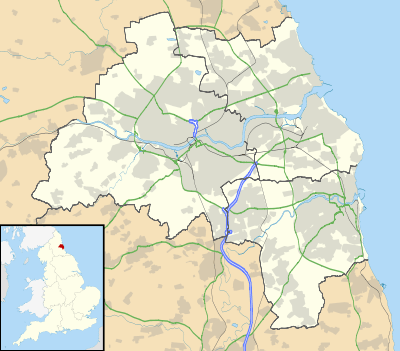Army Riding School, Newcastle upon Tyne
The Army Riding School was a military installation in Northumberland Road, Newcastle upon Tyne.
| Army Riding School | |
|---|---|
| Newcastle upon Tyne | |
.jpg) Army Riding School | |
 Army Riding School Location within Tyne and Wear | |
| Coordinates | 54.97684°N 1.61024°W |
| Type | Drill Hall |
| Site history | |
| Built | 1849 |
| Built for | War Office |
| Architect | John Dobson |
| In use | 1849-1975 |
History
The facility was designed by John Dobson and built to serve as a riding school for the Northumberland and Newcastle Volunteer Corps of Cavalry in 1849.[1] The regiment was renamed the Northumberland (Hussars) Yeomanry Cavalry in 1876[2] and the Northumberland Yeomanry in 1908.[3] The regiment was mobilised at the riding school in September 1916 before landing at Zeebrugge for service on the Western Front.[3] The riding school was used as an operational headquarters during the Miners strike in early 1921 and continued to be used by the regiment as its regimental headquarters until the Second World War.[4]
Meanwhile, the 6th Battalion the Northumberland Fusiliers moved from the St Mary's Place drill hall in Newcastle upon Tyne (since demolished) to the Army Riding School, referred to by the Northumberland Fusiliers as "St George's drill hall", in 1908.[5] The 6th Battalion then moved to the Church Street drill hall in Walker (since demolished) in 1920.[5][6]
The Northumberland Yeomanry re-occupied the riding school in 1946 in its new capacity as the 50th (Northumbrian) Divisional Reconnaissance Regiment.[7] However, the regimental headquarters and 'A' Squadron moved to Debden Gardens in Heaton in 1954.[8] Instead, the riding school became known as the Yeomanry Drill Hall and, in that capacity, served as a drill hall for the Northumbrian Universities Officers' Training Corps in the 1960s.[9] After the Officers' Training Corps moved to St George's Army Reserve Centre in Jesmond in the 1975,[10] the building was decommissioned and became the City of Newcastle Employers Club.[11] The building is now occupied by Northumbria University which uses it as an information technology centre and as a lecture theatre facility for its law school.[12] It is a Grade II Listed building.[11]
References
- "Newcastle, Northumberland Road, Army Riding School". Site Lines. Retrieved 4 June 2017.
- "A brief history of the Northumberland (Hussars) Yeomanry Cavalry 1819-1918". Bailiffgate Museum. Retrieved 4 June 2017.
- "The Northumberland Yeomanry". The Long, Long Trail. Retrieved 4 June 2017.
- Holmes, David. "The Drill Hall". Northumbria University. Retrieved 4 June 2017.
- "6th Battalion, The Royal Northumberland Fusiliers". Regiments.org. Archived from the original on 20 October 2007. Retrieved 7 July 2017.CS1 maint: BOT: original-url status unknown (link)
- "Army List 1937". Retrieved 7 July 2017.
- Hewitson, p. 74
- Hewitson, p. 76
- "Northumbrian Universities Contingent, Officer Training Corps". The Courier. 17 October 1963. Retrieved 7 May 2017.
- Allen, p. 79
- Historic England. "City of Newcastle Employers Club (1106254)". National Heritage List for England. Retrieved 4 June 2017.
- Allen, p. 146
Sources
- Hewitson, T.L. (2006). Weekend Warriors from Tyne to Tweed. Stoud: Tempus Publishing Limited. ISBN 0-7524-3756-9.
- Allen, Joan (2005). Rutherford's Ladder: The Making of Northumbria University, 1871-1996. Northumbria University Press. ISBN 978-1904794097.